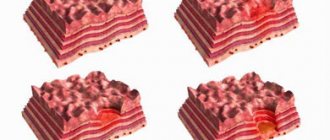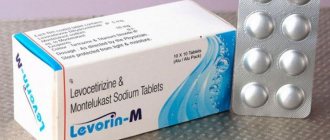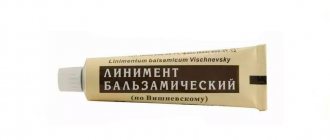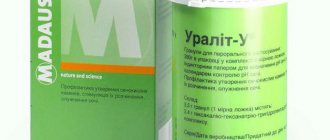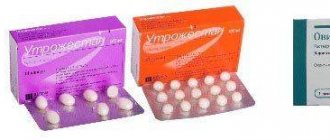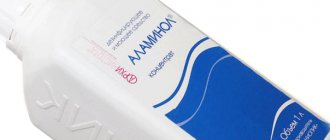Write a review
Reviews: 0
Manufacturers: Lannacher Heilmittel GmbH
Active ingredients
- Iron fumarate
- Folic acid
Disease class
- Iron-deficiency anemia
- Malnutrition during pregnancy
- Bleeding not elsewhere classified
- Anemia complicating pregnancy, childbirth and the postpartum period
- Iron deficiency
Clinical and pharmacological group
- Not indicated. See instructions
Pharmacological action
- Replenishes iron deficiency
- Hematopoietic
Pharmacological group
- Hematopoiesis stimulants in combinations
- Macro- and microelements in combinations
Instructions for use of Ferretab
Ferretab Composite capsules are produced by the Austrian company GL Pharma GmbH. The product is intended to normalize the level of iron in the blood or maintain its concentration, has a hematopoietic effect (promotes hematopoiesis) . It owes its effectiveness to the combination of two active substances: iron fumarate and vitamin B9. The first promotes the synthesis of hemoglobin, the second is necessary for the proper maturation of normoblasts, the precursors of red blood cells.
Composition of Ferretab
The medicine Ferretab is produced in the form of capsules, inside of which there are four mini-tablets. Three of them contain iron fumarate, one contains vitamin B9. The medicine is packaged in cardboard packages, inside - from three to ten blisters, each of which contains 10 capsules. The product contains:
| Component | Dosage (mg) | Properties |
| Iron fumarate | 152.1, which corresponds to 50 mg of iron (II) | Replenishes iron deficiency |
| Folic acid (water-soluble vitamin B9) | 0,5 | Strengthens the immune system and cardiovascular system. Needed for the production of nucleic acids, normoblasts, amino acids, pyrimidines, purines. Promotes the maturation of red blood cells and megaloblasts. |
| Lactose monohydrate | 3.42 (iron tablets) + 24.21 (vitamin B9 tablet) | Filler. |
| Polyacrylate dispersion 30% | Additive. | |
| Silicon dioxide colloidal | 0,6 + 0,5 | Enterosorbent is effective for purulent inflammation of soft tissues. |
| Magnesium stearate | 0,6 + 0,5 | A thickener that gives the tablet its shape. |
| Methyl methacrylate and ethyl acrylate copolymer (2:1) | 4,66 | Provides prolonged action. |
| MCC (microcrystalline cellulose) | 24,25 | Improves the functioning of the digestive system, binds toxins, reduces sugar and cholesterol. |
| Capsule: | ||
| Gelatin | 24,3203 | |
| Azorubine | 0,0498 | Dye. |
| Quinoline yellow | 0,0996 | Dye. |
| Titanium dioxide | 0,3303 | |
Pharmacodynamics and pharmacokinetics
Iron deficiency anemia is caused by a lack of iron (Fe). This substance is an integral part of heme, which is part of hemoglobin, and is responsible for attaching oxygen, which then enters the tissues as part of red blood cells and participates in oxidative processes. After red blood cells deliver oxygen to the tissues, they take carbon dioxide from there and carry it to the lungs, through which the carbon dioxide leaves the body.
With a lack of iron, hemoglobin loses its ability to absorb oxygen and carbon dioxide, and the body begins to experience oxygen starvation, which negatively affects its functioning. The causes of the pathology are:
- severe blood loss;
- problems with mineral absorption;
- congenital Fe deficiency;
- increased need for iron;
- a problem with the transfer of minerals throughout the body due to a lack of the transport protein transferrin.
Ferretab tablets solve the problem of iron deficiency. After entering the digestive system, the active substance is slowly released so as not to irritate the mucous membrane. After absorption, most of the mineral attaches to transferrin. Then it begins to produce hemoglobin and other elements whose activity is related to oxygen (catalase, myoglobin, peroxidase, cytochrome oxidase). The remainder is absorbed in the reticuloendothelial system (macrophage cells that destroy foreign or toxic particles).
Vitamin B9 is absorbed into the plasma in the upper gastrointestinal tract (duodenum). Most of the folic acid combines with proteins, after which it enters the cells in the blood and performs its functions. The active substances of the drug are processed by the liver, after which they leave the body in feces, urine, and sweat.
Indications for use
The main indication for taking Ferretab is iron deficiency anemia. The drug is prescribed for the prevention and treatment of iron deficiency anemia with:
- pregnancy;
- lactation;
- poor nutrition;
- alcoholism;
- severe or prolonged infectious diseases;
- use of oral contraceptives or anticonvulsants.
- impaired metabolism and absorption of iron due to colitis, stomach ulcers;
- with prolonged bleeding of various types (uterine, from the stomach, bladder, menstruation).
Iron deficiency anemia can be determined by the low content of red blood cells and hemoglobin, which is shown by a complete blood count .
To clarify the diagnosis, it is necessary to do biochemical studies of the plasma. In case of iron deficiency anemia, tests will show a low concentration of ferritin (the main form of iron deposition) and a low serum iron content. In addition, there will be a high indicator of TIBC (total iron-binding capacity of serum), low saturation of transferrin with the mineral.
Release forms and composition of the drug
This product is available in the form of hard capsules with a bright red gelatin shell. The medicine has a prolonged effect.
Inside each capsule there are several small flat-shaped tablets: three of them contain a high concentration of iron fumarate, and the fourth contains folic acid. Ferrum-enriched tablets have a distinct red-brown tint and dark inclusions.
The composition of each individual Ferretab capsule, consisting of 4 parts, is represented by the following ratio of active ingredients:
- about 163 mg of iron fumarate, which is equivalent to 50 mg of pure ferrum absorbed by the body;
- 0.54 mg of folic acid, equivalent to 0.5 mg of dry matter.
In addition to the main substances, auxiliary components were used in the manufacture of the drug:
- magnesium stearate;
- lactose monohydrate;
- colloidal silicon dioxide;
- cellulose;
- gelatin;
- dyes;
- ethyl acrylate;
Each cardboard package contains 3 blisters of 10 capsules.
Ferretab belongs to the clinical-pharmacological group of antianemic drugs and vitamin-mineral complexes.
Directions for use and dosage
According to the instructions, Ferretab should be taken half an hour to an hour before a meal, but if nausea or an unpleasant aftertaste appears after the medication, it can be taken after meals. The medicine should be swallowed completely with plenty of plain water or a drink containing vitamin C, which stimulates the absorption of iron . Products that impair the absorption of the mineral should be consumed an hour or two after a meal. These include:
- coffee, black tea;
- dairy products;
- raw cereals;
- bread;
- eggs.
The product can be taken from the age of twelve. Take the medicine once a day, one capsule. If hemoglobin is less than 80 mg/l, the doctor may prescribe 2-3 tablets (take 1 piece two to three times a day). The course of therapy lasts two to three months. The decision to stop taking the drug is made by the doctor after the hemoglobin concentration has stabilized. To achieve a stable result, the instructions recommend using the drug for a month after normalization of indicators.
Articles on the topic
- Leflobact - instructions for use and contraindications, side effects, mechanism of action and analogues
- Norfloxacin - instructions for use, side effects, mechanism of action, contraindications and analogues
- What is an erection - how the process occurs in the female and male body, what it depends on and how long it lasts
special instructions
In most cases, the drug normalizes hemoglobin levels, but in order to achieve the desired effect, it is necessary to find out the cause of anemia and begin to treat it. Ferretab may not be effective if:
- chronic alcoholism;
- circulatory failure;
- polyhypovitaminosis (incomplete deficiency of vitamins, when their number is enough to prevent serious pathology from developing, but too few for the normal functioning of the cells in which the element is involved).
After Ferretab, stool may turn black, which does not affect health, but may interfere with the diagnosis of chronic bleeding in the gastrointestinal tract. For the same reason, a test for the presence of hidden blood in excrement (benzidine test) can give a positive result. Ferretab does not affect the ability to drive or engage in activities that require increased attention and quick reaction.
Terms, conditions of sale and storage
Ferretab capsules do not require special storage conditions. It is advisable to keep the drug away from light and in a place inaccessible to small children. The shelf life of the medicine for anemia is 3 years from the date of release at a temperature not exceeding 25 °C. Ferretab cannot be used after the expiration date.
Ferretab
This drug is available from pharmacies in over-the-counter form, but self-medication is not a suitable treatment option. In order for the use of iron-containing medication to bring positive results and not cause complications, you must consult a doctor before purchasing the drug.
Ferretab during pregnancy
The drug Ferretab can be used when a woman is expecting or nursing a baby, since it contains iron and vitamin B9, which doctors recommend for the successful development of the child and the prevention of miscarriage. For prevention, 1 capsule per day is prescribed until the 12th week of gestation. If after this period the risk of anemia has not disappeared, you can take it before birth according to the same regimen. If the probability of illness is low, the drug can be taken in courses, with breaks of a month. If anemia is present, the doctor may increase the dose by prescribing 1 capsule 2-3 times a day for 2-3 months.
Drug interactions
If the patient is taking other medications during treatment with Ferretab, he should notify the doctor about this, as they may affect the effectiveness of each other. Thus, iron salts can reduce absorption:
- DNA hydrase inhibitors (Levofloxacin, Ciprofloxacin);
- bisphosphonates (prevent bone loss);
- Levodopa, Carbidopa - used for Parkinson's disease;
- Methyldopa - prescribed for hypertension;
- penicillin;
- Sulfasalazine – for the treatment of rheumatoid arthritis;
- thyroxine - used for problems with the thyroid gland.
Ferretab is less absorbed if taken simultaneously with magnesium and calcium supplements, Carbamazepine, Phenytoin, Phenobarbital. Simultaneous use of the drug with non-steroidal anti-inflammatory drugs increases irritation of the mucous membrane of the digestive system. Vitamin E reduces the healing properties of Ferretab. Simultaneous use with glucocorticosteroids enhances erythropoiesis (the process of hematopoiesis during which red blood cells are formed).
Vitamin B9 reduces the effectiveness of hormonal contraceptives taken orally, Primidone (an antiepileptic drug), Sulfasalazine (for the treatment of rheumatoid arthritis). Vitamin B9 is less easily absorbed when taken simultaneously with:
- analgesics – painkillers;
- anticonvulsants;
- cholestyramine – has a hypocholesterolemic effect;
- antacids – neutralize hydrochloric acid in the stomach;
- antibiotics (tetracycline, neomycin, etc.);
- cytostatics (methotrexate) – antitumor drugs;
- triamterene – diuretic;
- sulfonamides - antimicrobial drugs.
Side effects of Ferretab
Iron-containing preparations rarely cause complications. Among them are:
- nausea;
- vomiting; constipation;
- flatulence;
- black stool;
- pain in the upper abdomen;
- paroxysmal nocturnal hemoglobinuria (a very rare disease of the hematopoietic system, due to which blood cells lack a number of proteins);
- an allergic reaction expressed by a rash, itching, redness of the skin.
At what age can the drug be used?
Like many other iron-containing drugs, Ferretab is used with caution in childhood.
Doctors, as a rule, do not prescribe this medicine to patients under 12 years of age because of its irritating effect on the mucous membranes of the digestive system. In addition, when treating anemia in low weight children, the risk of overdose is quite high.
Overdose
Ferretab should be taken in strictly specified doses, otherwise complications, including death, are possible if the dosage of iron taken exceeds 180 mg per kilogram of body. For some patients, a dose of 30 mg/kg of body may be toxic. Symptoms of an overdose do not appear immediately, but after several hours:
- during the first six hours - vomiting, diarrhea, gastrointestinal bleeding, abdominal pain, shock, coma;
- after 6-24 hours - fever, increased white blood cells, metabolic acidosis (decreased blood acidity, low bicarbonate levels), coagulopathy (clotting problems), kidney and liver problems.
An overdose can provoke hemorrhagic gastroenteritis, characterized by inflammation of the gastric mucosa, accompanied by erosion and ulcers, and gastric bleeding. Symptoms include vomiting and bloody diarrhea. You can also get poisoned if you take the drug for an unjustifiably long time. In this case, hemosiderosis is possible, in which excessive deposits of the hemosiderin pigment occur in the tissues and their destruction.
If symptoms of poisoning appear, vomiting should be provoked by washing the stomach with a weak solution of baking soda. If this cannot be done, you need to drink milk and raw eggs, which will bind iron atoms, reducing their absorption into the blood, reducing the symptoms of poisoning. After this, take Desferal and seek medical help.
Contraindications
Like any drug, Ferretab has contraindications. These include:
- allergies to the components of the product, including lactose intolerance;
- diseases that lead to the accumulation of iron in tissues (hemochromatosis, hemosiderosis, chronic hemolysis);
- problems with iron absorption (thalassemia, anemia due to lead poisoning);
- hemoglobinopathy (changes or disturbances in the structure of hemoglobin);
- aplastic anemia – the bone marrow stops producing red blood cells, leukocytes, platelets in the required quantity;
- hemolytic anemia, provoked by increased breakdown of red blood cells;
- pernicious anemia caused by a lack of vitamin B12;
- other types of anemia not associated with a lack of Fe or B9;
- intestinal obstruction, esophageal stenosis, intestinal inflammation and other obstructive diseases of the digestive system, stomach and duodenal ulcers at the acute stage;
- regular blood transfusions;
- use of other iron-containing drugs by injection;
- age up to 12 years.
Pharmacological properties
The effect of a medicine on the body is determined by the effects of the substances it contains. The complex of iron and folic acid on which Ferretab is based is a powerful stimulator of the formation of blood cells.
With a deficiency of these components, a pathological condition such as iron deficiency anemia develops. The disease can lead to hypoxia of internal organs due to insufficient hemoglobin concentration.
With oxygen starvation and a lack of folic acid, the risk of developing megaloblastic anemia increases. In this case, there is a failure in the mechanism of red blood cell production and hemoglobin synthesis. Ferretab's task is to restore the balance of blood cells and hemoglobin in the blood.
This medicine in capsules improves the well-being of pregnant women and has a positive effect on the formation of organs and systems of the fetus, and replenishing folic acid reserves minimizes the likelihood of premature birth and prevents the threat of miscarriage.
Also, the therapeutic properties of iron fumarate and folic acid are as follows:
- more intensive absorption of ferrum contained in food products;
- proper hematopoiesis within the bone marrow;
- increasing immunity.
Ferretab's analogs
The drug Ferretab can be replaced with drugs with a similar effect, but with a different active substance. Among them:
- Tablets, drops, Maltofer syrup (Switzerland). Contains iron (III) hydroxide polymaltose. In syrup form, it can be taken by infants and is recommended for premature babies.
- Chewable tablets, capsules Biofer (India). Contains iron (III) hydroxide polymaltosate and vitamin B9. Allowed from 6 years.
- Tardiferon tablets (France). Active ingredients: dry iron sulfate. Recommended for children over 7 years old.
- Tablets Gino-Tardiferon (France). Active ingredients: dry iron sulfate, vitamin B9. Not recommended for children under 7 years old.
- Drops, syrup, capsules Aktiferrin (Germany). Active ingredients: iron sulfate heptahydrate, D, L-serine. Drops can be used for newborns, syrup after two years, tablets - from six years.
- Ferlatum solution (Spain). Contains iron protein succinylate. Recommended for infants.
- Ferry-Fol tablets (USA). Contains iron [III] hydroxide polymaltosate, vitamin B9.
Pharmacodynamics and pharmacokinetics
The active microelements of the drug are the main participants in chemical and biological processes associated with the delivery of oxygen to the cells and tissues of the body.
Iron fumarate is a salt, without which hemoglobin synthesis does not occur. In addition, it is this substance that promotes the gradual regression of laboratory manifestations and symptoms of iron deficiency pathological conditions (general weakness, fatigue, dryness, pain when touching the epidermis, cardiac arrhythmia).
Folic acid ensures the continuity of the production of normoblasts and the maturation of megaloblasts. This vitamin is involved in the metabolism of amino acids and the catalysis of purines, pyrimidines and nucleic acids, which stimulate hematopoiesis and protect the fetus from external teratogenic factors.
From the consumed amount of the drug, from 5 to 35% of the active components are absorbed. In the blood plasma, the active substances bind to transferrin, participating in the formation of myoglobin cells, peroxidase and catalase, or accumulating ferritin deposits in tissues.
Iron fumarate leaves the body with biological fluids and excrement. Folic acid is absorbed into the bloodstream at the level of the upper segments of the gastrointestinal tract, penetrating into the circulatory system through the mucous membrane of the duodenum. This microelement binds to the cell membrane by more than 60%. All stages of Ferretab metabolism take place in the liver.
Ferretab price
Ferretab capsules are sold in pharmacies in Moscow and the Moscow region. The price for thirty tablets ranges from 300 rubles:
| Pharmacy name | Cost in rubles |
| Dialogue | 279 |
| Zdravzona | 298 |
| Laboratory of Beauty and Health | 333 |
| Europharm | 360 |
| IFC | 444 |
